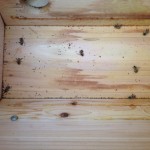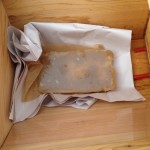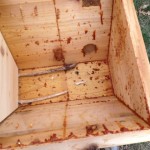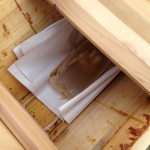Candy
The weather has continued to stay unusually warm and the bees are eating more honey due to their increased activity. I had put sugar syrup feeders in the hives. When I checked on the bees a few days after I had installed the feeders, they had not been eating the sugar syrup. The bees in the hive at my house have less honey stored than the host hive does. After going through the hives, I don’t think that either of the hives has enough honey to get through the winter.
I spent some time reading and talking to other bee keepers about winter feeding, especially for top bar hives. I decided to make candy for them. The next step was to find a good recipe for the candy. There are a lot of really gross recipes for bee candy on the internet! I found one for hard candy on www.honeybeesuite.com that I modified.
I decided to make the hard candy over the fondant because the weather has been fluctuating so much. From what I read, fondant can occasionally melt. In the top bar hive there is no candy board and I didn’t want the candy to liquefy at all and end up all over the bottom of the hive.
The candy I made was 4 cups of sugar, 12.8 ounces of water, 1 tsp and a little extra of lemon juice, and I added 5 drops of lemongrass and spearmint essential oils. I followed the instructions on www.honeybeesuite.com for how to make the candy. For forming the candy, I used bread pans instead of paper plates. I needed the candy to be rectangular instead of circular. I just lined the pans with parchment paper since I don’t use canola oil for anything. The bread pans were the perfect size and shape for my hives.
Outside the temperature was about 50 degrees and it was mostly cloudy. My initial plan was just to put the blocks of candy into the hives. I started with the hive in my yard. I opened it up and took out the syrup feeders. When I took the syrup feeders out, I got quite an awful surprise.
There were several dead bees on the bottom and lots of mites! I don’t understand why they were there. It seemed like a strange place for the mites to be. The bees never even lived in that part of the hive. There were so many mites in there.
I decided to take a peak inside the nest to see if the colony was still there. I only partially took out one bar and there was a small cluster of bees and they made a good amount of noise to let me know to close the hive! I put the bar back into the hive and closed up the hive as tightly as I could.
Seeing all of those mites in the hive at my house was very concerning. Now I needed to put the candy into the host hive and look for mites there too. The host hive has been a strong colony all along. They have more honey stores and they used a lot more propolis on the hive than the hive in my yard. They even made the entrance reducer smaller by filling about 2/3 of it with propolis.
When I got to the host hive, I checked the entrance first. The bees were active today. I watched them flying out of the hive and returning. Then I checked though the window to see if they were taking any of the syrup. The bees have not been taking the syrup, which is what I had suspected. They have honey and they would much rather eat that.
I opened the feeder area to remove the syrup feeders. Once open, I spent some time looking in the feeder cavity. I did not find any mites like I had in the other hive. There were just a couple of dead bees and lots of propolis. This colony has done really well coating most of their hive with propolis. It may be that they are so close to conservation land that they are able to collect so much of it.
Once I was done viewing the feeder cavity, I put the candy block in the hive on top of the folded paper. Then I closed up the feeder cavity. I decided not to open the area where the colony is, but I knocked on the bars where I think the bees are. The bees kindly responded to my knocking with a lovely sound of buzzing!



